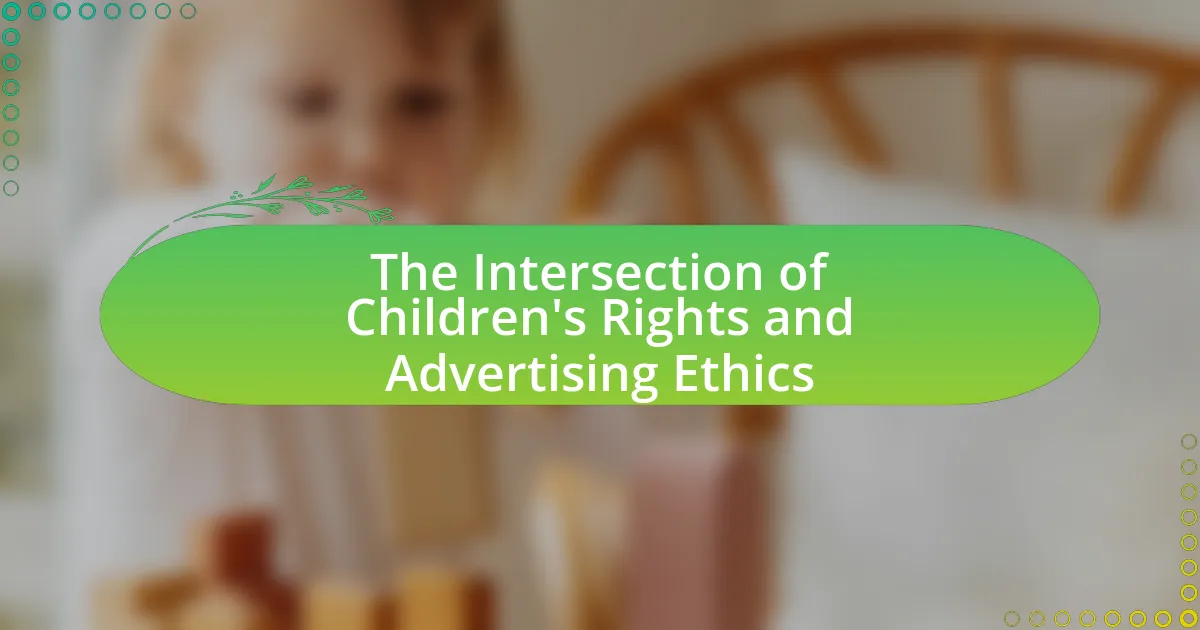Transparency in children’s advertising is essential for fostering trust and protecting young audiences from misleading information. The article explores the significance of clear communication in marketing directed at children, emphasizing the need for honesty, clarity, and responsibility to prevent exploitation and manipulation. It discusses the ethical considerations surrounding children’s advertising, the impact of transparency on children’s understanding of marketing messages, and the potential consequences of deceptive practices. Additionally, the article outlines best practices for advertisers to enhance transparency, the benefits for both brands and consumers, and the regulatory standards that govern ethical advertising aimed at children.
What is the Importance of Transparency in Children’s Advertising?
Transparency in children’s advertising is crucial as it fosters trust and protects young audiences from misleading information. When advertisers clearly disclose the nature of their messages, children can better understand the difference between entertainment and marketing, which is essential for their cognitive development. Research indicates that children are particularly vulnerable to persuasive tactics, making transparency vital to ensure they are not exploited. For instance, the American Psychological Association highlights that children under eight often lack the ability to critically evaluate advertising, underscoring the need for clear and honest communication in marketing directed at them.
Why is transparency crucial in advertising targeted at children?
Transparency is crucial in advertising targeted at children because it helps protect young audiences from misleading information and promotes ethical marketing practices. Children are particularly vulnerable to persuasive messages due to their developmental stage, making it essential for advertisers to clearly disclose the intent and nature of their advertisements. Research from the American Psychological Association indicates that children under the age of eight often do not understand the persuasive intent of advertising, which underscores the need for transparency to ensure they can make informed decisions. By being transparent, advertisers can foster trust and accountability, ultimately contributing to a safer advertising environment for children.
What ethical considerations arise in children’s advertising?
Ethical considerations in children’s advertising primarily involve the potential for exploitation and manipulation of young audiences. Advertisers must recognize that children are impressionable and may not fully understand the persuasive intent behind advertisements, leading to concerns about misleading claims and the promotion of unhealthy products. Research indicates that children are particularly vulnerable to advertising tactics, which can influence their preferences and consumption behaviors, potentially resulting in negative health outcomes, such as obesity. Furthermore, ethical advertising practices should prioritize transparency, ensuring that children and their guardians can discern the difference between entertainment and marketing. This aligns with guidelines set forth by organizations like the American Psychological Association, which emphasizes the need for responsible advertising that protects children from undue influence.
How does transparency impact children’s understanding of advertising?
Transparency significantly enhances children’s understanding of advertising by allowing them to discern the intent behind marketing messages. When advertisements clearly disclose their purpose and the nature of the products being promoted, children are better equipped to critically evaluate the content. Research indicates that children aged 8 to 12 who are exposed to transparent advertising practices demonstrate improved comprehension of persuasive intent, as shown in a study published in the Journal of Consumer Research by authors Anna S. McAlister and John D. B. McDonald. This understanding helps children develop critical thinking skills regarding media consumption, reducing susceptibility to misleading claims.
What are the key principles of transparency in children’s advertising?
The key principles of transparency in children’s advertising include honesty, clarity, and responsibility. Honesty requires that advertisements do not mislead children about the nature or benefits of a product. Clarity involves using language and visuals that children can easily understand, ensuring that the intent of the advertisement is clear. Responsibility emphasizes the ethical obligation of advertisers to consider the impact of their messages on children’s well-being. These principles are supported by guidelines from organizations such as the American Psychological Association, which highlights the need for truthful representation in marketing directed at children to protect them from exploitation and misinformation.
How can advertisers ensure clarity in their messaging?
Advertisers can ensure clarity in their messaging by using straightforward language and avoiding jargon. Clear messaging helps children and parents easily understand the advertisement’s intent and content. Research indicates that advertisements aimed at children should use simple, direct language to enhance comprehension, as children may struggle with complex vocabulary. For instance, a study published in the Journal of Advertising Research found that ads with clear, concise messages significantly improved children’s recall and understanding of the product being advertised. This approach not only fosters transparency but also builds trust with the audience.
What role does honesty play in children’s advertising?
Honesty plays a crucial role in children’s advertising by fostering trust and promoting ethical standards. When advertisements are truthful, they help children develop critical thinking skills and discernment regarding marketing messages. Research indicates that children are particularly vulnerable to misleading claims, making transparency essential for their understanding of products. For instance, the American Psychological Association emphasizes that honest advertising can mitigate the risk of children developing unrealistic expectations about products, thereby supporting healthier consumer habits.
What are the potential consequences of a lack of transparency?
A lack of transparency in children’s advertising can lead to significant consequences, including the erosion of trust between consumers and brands. When advertisers do not clearly disclose the nature of their marketing efforts, children may be misled about the products being promoted, which can result in unhealthy consumption habits. Research indicates that children are particularly vulnerable to deceptive advertising practices, as they often lack the cognitive skills to critically evaluate marketing messages. This vulnerability can lead to increased rates of obesity and other health issues, as children may be more likely to choose unhealthy foods based on misleading advertisements. Furthermore, a lack of transparency can damage a brand’s reputation, as parents may become distrustful and choose to avoid brands that do not prioritize honesty in their advertising practices.
How can misleading advertising affect children’s behavior?
Misleading advertising can significantly alter children’s behavior by shaping their perceptions and expectations about products. Children, who are often unable to critically evaluate advertisements, may develop unrealistic desires for products that do not deliver on the promises made in ads. For instance, a study published in the journal “Pediatrics” found that children exposed to misleading food advertisements were more likely to choose unhealthy snacks over healthier options, demonstrating a direct link between deceptive marketing and poor dietary choices. This manipulation can lead to long-term habits and preferences that affect their health and well-being.
What are the long-term implications for brands that lack transparency?
Brands that lack transparency face significant long-term implications, including diminished consumer trust and potential reputational damage. Research indicates that 81% of consumers prefer to buy from brands that are transparent about their practices, and a lack of transparency can lead to negative perceptions and decreased customer loyalty. Over time, this erosion of trust can result in reduced sales and market share, as consumers increasingly gravitate towards competitors that demonstrate openness and accountability. Furthermore, brands may encounter regulatory scrutiny and legal challenges, particularly in sensitive areas like children’s advertising, where transparency is crucial for ethical compliance.
How does transparency in children’s advertising relate to regulatory standards?
Transparency in children’s advertising is closely linked to regulatory standards that aim to protect young audiences from misleading or harmful content. Regulatory bodies, such as the Federal Trade Commission (FTC) in the United States, enforce guidelines that require advertisers to disclose material information clearly and ensure that advertisements are not deceptive. For instance, the Children’s Online Privacy Protection Act (COPPA) mandates that websites directed at children must provide clear information about data collection practices, reinforcing the need for transparency. This regulatory framework is designed to foster trust and safeguard children’s rights, ensuring that advertising practices are ethical and responsible.
What are the best practices for achieving transparency in children’s advertising?
The best practices for achieving transparency in children’s advertising include clear labeling of advertisements, using age-appropriate language, and ensuring that content is easily distinguishable from entertainment. Clear labeling helps children and parents identify promotional content, while age-appropriate language ensures comprehension. Research by the American Psychological Association indicates that children under eight years old often cannot distinguish between advertising and programming, highlighting the need for clear differentiation. Additionally, adhering to guidelines set by organizations such as the Children’s Advertising Review Unit promotes ethical standards in advertising targeted at children.
How can brands effectively communicate their advertising intentions?
Brands can effectively communicate their advertising intentions by prioritizing transparency and clarity in their messaging. This involves clearly stating the purpose of the advertisement, the target audience, and the benefits of the product or service being promoted. Research indicates that transparent advertising fosters trust; for instance, a study by the American Psychological Association found that consumers are more likely to engage with brands that openly disclose their advertising strategies. By using straightforward language and avoiding misleading claims, brands can ensure that their intentions are understood, particularly in sensitive areas like children’s advertising, where ethical considerations are paramount.
What tools can be used to enhance transparency in advertising campaigns?
Tools that can enhance transparency in advertising campaigns include analytics platforms, disclosure guidelines, and third-party verification services. Analytics platforms, such as Google Analytics, provide insights into campaign performance, allowing advertisers to share data with stakeholders. Disclosure guidelines, like those established by the Federal Trade Commission, require clear communication of sponsored content, ensuring that audiences understand the nature of advertisements. Third-party verification services, such as the Media Rating Council, audit and validate advertising metrics, fostering trust by confirming that claims made by advertisers are accurate and reliable. These tools collectively contribute to a more transparent advertising environment, particularly in sensitive areas like children’s advertising, where ethical considerations are paramount.
What are the benefits of transparent advertising for brands and consumers?
Transparent advertising benefits brands and consumers by fostering trust and enhancing brand loyalty. For brands, transparency leads to improved customer relationships, as consumers are more likely to engage with companies that openly share information about their products and practices. A study by the Edelman Trust Barometer found that 81% of consumers need to trust a brand to buy from them, highlighting the importance of transparency in building that trust. For consumers, transparent advertising provides clarity and helps them make informed decisions, reducing the likelihood of deception and dissatisfaction. This mutual benefit creates a more ethical marketplace, where brands that prioritize transparency can differentiate themselves and attract a loyal customer base.
How does transparency build trust with parents and guardians?
Transparency builds trust with parents and guardians by providing clear and honest information about products and practices. When parents are informed about how children’s advertising operates, including the intentions behind marketing strategies and the safety measures in place, they feel more secure in their decisions. Research indicates that 85% of parents are more likely to trust brands that openly communicate their values and practices, as this openness fosters a sense of partnership and accountability. By ensuring that parents understand the content and context of advertisements aimed at their children, companies can create a trustworthy environment that reassures guardians about their children’s exposure to marketing.
What positive outcomes can arise from transparent advertising practices?
Transparent advertising practices can lead to increased consumer trust and brand loyalty. When companies openly disclose their advertising methods and the content of their messages, consumers feel more informed and empowered, which fosters a sense of reliability. Research from the American Marketing Association indicates that 81% of consumers prefer brands that are transparent about their practices. Additionally, transparent advertising can enhance brand reputation, as companies that prioritize honesty are often viewed more favorably by the public. This positive perception can result in higher customer retention rates and increased sales, as consumers are more likely to support brands they trust.
What strategies can advertisers implement to promote transparency in their campaigns?
Advertisers can promote transparency in their campaigns by clearly disclosing the intent and nature of their messaging. This includes using straightforward language to explain the purpose of advertisements, ensuring that children and parents understand the content and its implications. For instance, the Federal Trade Commission (FTC) emphasizes the importance of clear disclosures in advertising directed at children, which helps build trust and understanding. Additionally, advertisers can implement age-appropriate content that aligns with ethical standards, thereby fostering an environment where children can critically engage with advertisements. Research indicates that transparency in advertising can lead to increased consumer trust, as seen in studies conducted by the American Psychological Association, which highlight the positive effects of clear communication on audience perception.






